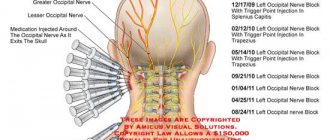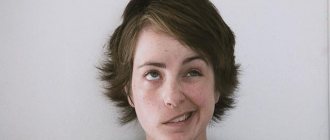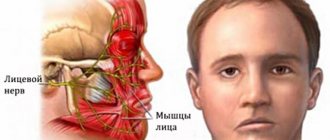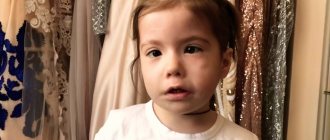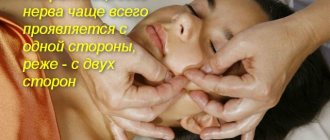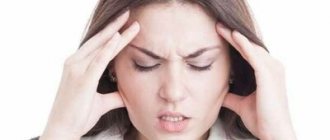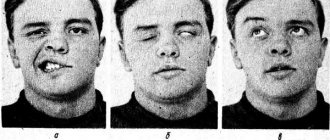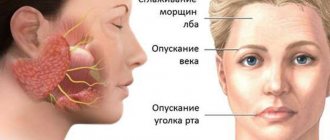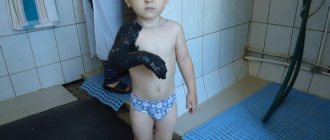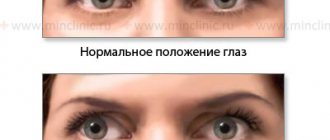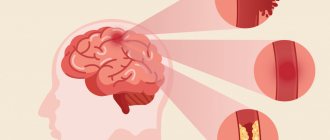The facial nerve is responsible for the activity of all facial muscles. This nerve provides the ability to express emotions, squint, smile, etc. A person with facial paralysis does not have this option.
The Neurology Clinic of the Yusupov Hospital in Moscow offers services for high-quality diagnostics, effective treatment of facial paralysis, as well as successful rehabilitation of patients after an illness.
Facial nerve paralysis: causes of development
The exact cause of this disease has not been determined to date. However, it is known that the trigger for the development of facial paralysis can be damage to the following infectious viral pathologies:
- herpes infection;
- chickenpox and herpes zoster;
- adenoviral infections, acute respiratory viral infections, influenza;
- mononucleosis (Epstein-Barr virus);
- cytomegalovirus;
- Coxsackie virus;
- rubella.
In addition, paralysis of the facial nerve can occur with hypothermia, alcohol abuse, cancer in the brain, severe stressful situations, hypertension, head injuries (ears, face), atherosclerotic changes in blood vessels, dental diseases, diabetes, otitis media and sinusitis.
The risk group for the development of facial nerve paresis includes women during pregnancy and after childbirth, elderly people, especially those with weakened immune systems. The incidence of the disease increases during viral epidemics.
Among experts there is also an opinion about hereditary factors of the disease.
Emmanuel Beart
Source: @emmanuellebeart
In the case of this French actress, we are talking about incorrectly performed lip correction. Emmanuelle had this plastic surgery a long time ago, when she was only 27 years old. It is possible that the doctor did not have enough qualifications to carry out this operation, but the fact remains: in order to correct the shortcomings, the French woman again required surgical intervention, but it did not help her either. Today the actress’s mouth looks unnatural, but the star is not ready to experiment anymore.
Facial nerve paralysis: symptoms
The development of facial paralysis is characterized by an acute onset: the condition of patients worsens quite sharply.
However, initial symptoms can be detected at an early stage of the disease, one to two days before visual manifestations appear.
Facial nerve palsy may present with the following symptoms:
- soreness in the area of the auricle, extending to the back of the head or face;
- pain in the eye from the affected area.
The appearance of the first signs is associated with an increase in swelling of the nerve column and its gradual compression.
Then more pronounced signs of facial paresis appear:
- violation of facial symmetry;
- lack of facial expressions and emotionality on the affected side of the face;
- drooping of the corner of the mouth, smoothing of the nasolabial fold, frontal folds on the affected side of the face;
- increased facial symmetry when trying to smile, speak, or cry;
- inability to completely close the upper eyelid;
- difficulty keeping liquid food and drinks in the mouth, pouring them from the affected side of the mouth - while the patient can chew and swallow normally;
- chewing food may be accompanied by biting the inside of the cheeks, which is associated with a lack of sensitivity in one’s own cheek;
- drying of the mucous membrane, decreased salivation (in some cases, on the contrary, its increase);
- impaired speech function associated with inactivity of certain parts of the mouth and lips;
- impaired blinking function, half-opening of the eye on the affected side, drying of the eye mucosa or, conversely, the appearance of excessive tearing;
- increased hearing on the affected side, changes in the perception of sounds (they seem louder to patients than usual);
- Patients have impaired taste sensations on the affected side of the tongue.
Lera Kudryavtseva
Source: @leratv
Another celebrity who refused implants is Russian TV presenter Lera Kudryavtseva. Like Victoria Beckham, the girl followed fashion and enlarged her breasts. However, endoprostheses installed more than 20 years ago must be replaced in a timely manner, since technologically they are far from perfect and can cause health problems.
During one of the screening studies, Lera learned that one of the implants was leaking and silicone had gotten into the tissue. After a difficult operation to remove endoprostheses and cleanse breast tissue, the star refused to install new ones, and enjoys a comfortable life with her natural breasts.
Facial paralysis: forms
There are several types of facial paralysis:
- Congenital facial paralysis occurs when the process of brain formation is disrupted in the prenatal period. In patients with this form of paralysis, there is a drooping of the corner of the mouth, a mask-like facial expression on the affected side, opening and moistening of the palpebral fissure. The skin on the cheek is smooth; during exhalation, the cheek on the affected side swells. The most severe form of congenital paralysis is Mobius syndrome;
- peripheral paralysis of the facial nerve - occurs if the patient has impaired motor function of the nerve trunk. With this type of paralysis, asymmetry occurs, complete immobility of the muscles of the affected part of the face;
- central paralysis of the facial nerve is caused by pathological changes in the cerebral cortex. The disease is most often localized in the lower part of the face. The main symptoms of central facial paralysis are: seizures, as well as involuntary muscle movements (a kind of tic).
Nicole Kidman
Source: @nicolekidman
The red-haired Australian at one time also decided to please her fans with a beautiful figure with an outstanding bust. After the operation, she sported very revealing outfits with a deep neckline. But since the actress plays sports, after some time she felt discomfort, especially when running. And soon she went back to the operating table. Today she is the owner of beautiful figures of small size, to the great joy of her husband.
Facial nerve paralysis: complications and consequences
In the absence of competent therapy, which requires a considerable amount of time and patience, facial paralysis can be aggravated by the development of the following complications:
- muscle atrophy (thinning and weakening of muscles), caused by prolonged dysfunction and impaired tissue trophism. This process is irreversible: restoration of atrophied muscles is impossible;
- facial contractures (muscle elasticity is lost on the affected side), spastic shortening of muscle fibers, muscle spasms. Visually, tension on the affected side and squinting of the eye are noted;
- facial muscle tics, spastic twitching (hemispasms, blepharospasms);
- associated movements (syncinesia) - characterized by the release of tears during chewing food, raising the edges of the lips when squinting the eyes;
- inflammatory processes in the conjunctiva or cornea of the eye, the development of which is associated with drying out of the eye mucosa as a result of its prolonged stay in an incompletely closed state.
Acupuncture
A further systematic examination of the use of acupuncture for NLN has revealed the fact that this method of acupuncture speeds up the recovery and reduces long-term disability in this condition. This included three randomized controlled studies that treated 288 patients with varying degrees of mimetic paralysis in an hourly interval up to 2 days after the onset of illness. The meta-analysis was not carried out due to the shortcomings of the study design, the clinical implications between them, and the presence of prognostic variables that were not verified for this purpose.
In two studies, it was found that after 10 days of stagnation of acupuncture, the prognosis for inflammation was worse, equal to that of corticosteroids in a complex with B vitamins, dibazole and herbal herbal remedies. In the first of them, the “forcible effect” became 74%, the “moderate effect” - 23%, the “significant effect” - 3% (as opposed to 45, 31 and 23% in the pharmacotherapy group, p < 0.01), in the other The level of “fork” increased to 83%, and the “moderate effect” - 17% (on the contrary, apparently, 45 and 10% of those who took the bait, p < 0.01). The third study found that after 15 days of acupuncture in combination with medications (dexamethasone, group B vitamins and ribavirin), the overall prognosis was better, compared with pharmacotherapy. With a comprehensive assessment of such an approach to treatment in a specific group, “strong effect” fell to 52%, “pronounced effect” - 26%, “moderate effect” - 21%, and “significant effect” - 2% (on against, apparently, 12, 54, 20 and 14% in the daily drug treatment group, p < 0.01). Each of the names does not know about the side effects. The authors of this review revealed an inadequate interpretation of pre-study methods, a lack of accuracy in the calculated prognostic values, and heterogeneity of both the established methods of acupuncture and the trivialities of vicoristic acupuncture and methods for assessing the prognosis. u. According to these findings, “the results indicate the positive effects of acupuncture in patients with LP, but the limited number of available studies does not allow us to formulate clear recommendations.”
Facial nerve paralysis: diagnosis
An experienced neurologist at the Yusupov Hospital can diagnose facial paralysis after the first examination of the patient. However, to determine the cause of the development of this disease, a general blood test may be prescribed to identify the inflammatory process and additional instrumental studies:
- magnetic resonance imaging for the possible detection of tumor processes, vascular disorders, inflammatory changes in the membranes of the brain, cerebral infarction;
- computed tomography - x-ray examination to identify the probable causes of the disease: post-stroke conditions, tumors, consequences of mechanical damage to the brain, disturbances of perinuclear blood flow;
- electroneurography - to determine the speed of passage of nerve impulses, which makes it possible to establish muscle atrophy, damage to the nerve branch, and the inflammatory process;
- electromyography with neurography - to identify the quality of intramuscular impulses for the diagnosis of muscle atrophy and contractures.
During the diagnostic process, facial nerve paresis must be differentiated from such pathologies as: stroke, Ramsay-Hunt syndrome, inflammatory processes in the mastoid process and middle ear, Lyme disease, temporal bone fractures, carcinomatosis or leukemia affecting the nerve trunk, chronic meningitis, tumor processes , multiple sclerosis, Guillain-Barre syndrome.
LITERATURE
- 1. Ahmed A. When is facial paralysis Bell palsy? Current diagnosis and treatment. Cleve Clin J Med. 2005 May;72(5):398-401, 405.
- 2. Alberton DL, Zed PJ. Bell's palsy: a review of treatment using antiviral agents. Ann Pharmacother. 2006 Oct;40(10):1838-42.
- 3. Allen D, Dunn L. Aciclovir or valaciclovir for Bell's palsy (idiopathic facial paralysis). Cochrane Database Syst Rev. 2004;(3):CD001869.
- 4. Gilden DH. Clinical practice. Bell's Palsy. N Engl J Med. 2004 Sep 23;351(13):1323-31.
- 5. He L, Zhou MK, Zhou D, Wu B, Li N, Kong SY, Zhang DP, Li QF, Yang J, Zhang X. Acupuncture for Bell's palsy. Cochrane Database Syst Rev. 2007 Oct 17;(4):CD002914.
- 6. Holland J. Bell's palsy. Clin Evid. 2006 Jun;(15):1745-50.
- 7. Holland NJ, Weiner GM. Recent developments in Bell's palsy. BMJ. 2004 Sep 4;329(7465):553-7.
- 8. Hughes R. Treatment of peripheral nerve disorders. Curr Opin Neurol. 2005 Oct;18(5):554-6.
- 9. Lunan R, Nagarajan L. Bell's palsy: a guideline proposal following a review of practice. J Paediatr Child Health. 2008 Apr;44(4):219-20.
- 10. Managing Bell's palsy. Drug The Bull. 2006 Jul;44(7):49-53.
- 11. Ohtake PJ, Zafron ML, Poranki LG, Fish DR. Does electrical stimulation improve motor recovery in patients with idiopathic facial (Bell) palsy? Phys Ther. 2006 Nov;86(11):1558-64.
- 12. Rahman I, Sadiq SA. Ophthalmic management of facial nerve palsy: a review. Surv Ophthalmol. 2007 Mar-Apr;52(2):121-44.
- 13. Salinas R. Bell's palsy. Clin Evid. 2003 Dec;(10):1504-7.
- 14. Salinas RA, Alvarez G, Ferreira J. Corticosteroids for Bell's palsy (idiopathic facial paralysis). Cochrane Database Syst Rev. 2004 Oct 18;(4):CD001942.
- 15. Shafshak TS. The treatment of facial palsy from the point of view of physical and rehabilitation medicine. Eura Medicophys. 2006 Mar;42(1):41-7.
- 16. Tiemstra JD, Khatkhate N. Bell's palsy: diagnosis and management. Am Fam Physician. 2007 Oct 1;76(7):997-1002.
- 17. Yeo SW, Lee DH, Jun BC, Chang KH, Park YS. Analysis of prognostic factors in Bell's palsy and Ramsay Hunt syndrome. Auris Nasus Larynx. 2007 Jun;34(2):159-64.
Facial nerve paralysis: treatment
The main method of treating facial paresis in the neurology clinic of the Yusupov Hospital is complex drug therapy using modern drugs of various effects:
- diuretics;
- anti-inflammatory drugs;
- glucocorticoids;
- antiviral drugs;
- antispasmodics;
- neurotropic drugs;
- vitamin preparations;
- agents for inhibiting cholinesterase.
Drug treatment of facial paralysis in the Yusupov Hospital in-patient department is carried out under the strict supervision of a neurologist, who can promptly adjust the dosage or replace the drug.
Physiotherapy
Physiotherapy, including physical exercises of the facial muscles and massage, has been used for a long time in the treatment of Bell's palsy. Today there was only one randomized follow-up study, which included 50 patients with severe mimetic paralysis (a trial period of 9 months) and in which a 10-year course was administered 4 5 sessions of physical therapy with limited rights are equal to any kind of treatment. Such treatment led to a significant increase in the number of blasphemous wounds, as well as associated physical and social disability. However, the results of the study were consistent with the previous observations, since the study was inconclusive and favored a heterogeneous control group.
